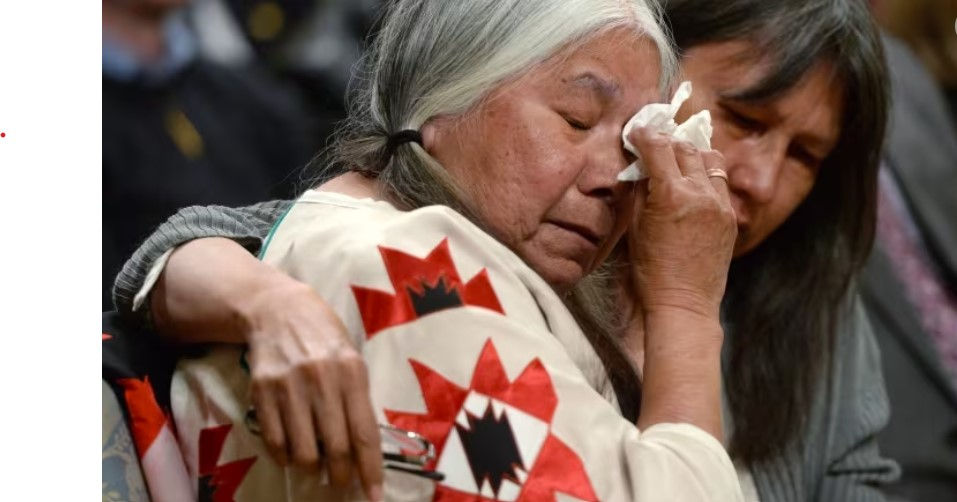Overview of Canada's 60s Scoop and Residential Schools
- Saphira Thomson

- May 11, 2024
- 3 min read
Updated: Oct 27, 2024

Indigenous history in Canada stretches back long before official records, but its controversial history over the last 157 years continues to have a profound impact today. The systematic issues of family separation, cultural erasure, and abuse have significantly impacted Indigenous identity and Canadian history[1].
The term "Sixties Scoop," coined by Patrick Johnson, refers to the “large-scale removal/scooping of Indigenous children from their homes, communities, and birth families through the 1960s.” The displacement of Indigenous children was driven by various factors, including assimilation policies, colonialism, and racial prejudice. Following their removal, many children were placed into foster care or adopted by predominantly white families[2], leading to a loss of cultural identity and connection to their communities.
Residential schools were “government-sponsored religious institutions that were established to assimilate Indigenous children into Euro-Canadian culture.” These schools aimed to replace Indigenous children’s cultural beliefs with Western ideals, rooted in the ethnocentric belief that these ways of life were superior[3]. Children in these institutions often endured physical, emotional, and cultural abuse. The trauma inflicted by these schools, like the Sixties Scoop, has left deep and lasting scars on Indigenous communities, contributing to intergenerational cycles of trauma and marginalisation.
The significance of both the Sixties Scoop and the residential school system remains relevant today because of the immense intergenerational trauma they caused. Survivors and their descendants continue to experience long-term emotional, social, and psychological trauma which has contributed to widespread issues such as increased poverty and addiction within Indigenous communities[4]. In a global context, movements for Indigenous land rights continue to be prevalent as countries grapple with their colonial histories[5]. These traumatic legacies are not confined to the past; they are ongoing, with repercussions that influence the lived experiences of Indigenous people today.
Despite the Canadian government’s efforts to create initiatives aimed at addressing these historical wrongs, controversies remain. Programs such as the Truth and Reconciliation Commission (TRC) and settlement agreements like the Indian Residential Schools Settlement Agreement (IRSSA) and the Sixties Scoop Settlement Agreement have been implemented, yet questions persist about their effectiveness. Some argue that the government’s actions are insufficient due to ongoing challenges with cultural preservation, trauma healing, and economic opportunity. Systematic barriers, such as inadequate funding, insufficient consultation, and bureaucratic delays, continue to hinder progress.
This blog is the first in a series that will examine the effectiveness of the Canadian government’s initiatives to address the injustices of the Indigenous residential school system and the Sixties Scoop. In upcoming entries, we will evaluate programs like the TRC, the settlement agreements, and other government-implemented efforts designed to address the grievances of individuals and communities affected by these policies. These blog posts will consider both the successes and shortcomings of these initiatives, aiming for a balanced and comprehensive view of the current state of reconciliation in Canada.
The long-lasting effects of the Sixties Scoop and residential schools highlight the necessity of reconciliation efforts that go beyond monetary compensation. While financial settlements provide some form of restitution, they do not fully address the emotional and psychological harm experienced by survivors and their families. Restored relationships, cultural revival, and comprehensive mental health support are crucial to true reconciliation. Yet, even as the government takes steps in this direction, many Indigenous communities still face significant barriers to healing and recovery.
As we delve deeper into this topic in future blogs, we will explore the diverse opinions and criticisms surrounding the Canadian government’s approach. By gathering multiple perspectives, we hope to provide a thorough analysis of whether these programs have effectively responded to the wrongs of the past or whether further efforts and a change in strategy are required. Ultimately, this series will argue that while the Canadian government’s initiatives are a step in the right direction, there is still much more to be done. Reconciliation must be an ongoing process, with continuous efforts to address not only the historical injustices but also the contemporary challenges facing Indigenous communities.
_________________________________________________________________________________
[1] Zach Parrott, “Indigenous Peoples in Canada,” ed. Michelle Filice, The Canadian Encyclopedia (Historica Canada, March 13, 2007),
[2] Niigaanwewidam James Sinclair and Sharon Dainard, “Sixties Scoop,” The Canadian Encyclopedia, June 22, 2016,
[3] J.R Miller, “Residential Schools in Canada,” The Canadian Encyclopedia (Historica Canada, October 10, 2012),
[4] Alvin Dixon, “The Sixties Scoop | Indian Residential School History and Dialogue Centre,” irshdc.ubc.ca, n.d.,
[5] Katie Reytar, Peter Veit, and Nicholas Tagliarino, “Indigenous Land Rights: How Far Have We Come and How Far Do We Have to Go?,” Www.wri.org, August 9, 2016,




Very interesting read Saphire. Thank you for this website.
Very important work Saphira. I look forward to reading more of your articles and learning more.
I enjoyed reading this !
Thank you for shedding light on the profound and ongoing impact of the Sixties Scoop and residential schools; it's crucial to recognize that true reconciliation requires more than just financial compensation - restoring cultural identity and community connections is essential for healing.
What a thoughtfully designed site that is rich in both facts but also highlights the human element of this very devastating part of Canadian history. I knew of this but not in so much detail.